Maxillofacial Injuries: Classification, Diagnosis, and Management
This article discusses the features of maxillofacial injuries, including soft tissue wounds, damage to the jaws and zygomatic bone, and management of traumatized patients. It covers pre-hospital and hospital care, as well as the importance of triage decisions and maintaining an unobstructed airway. The article also explores the sequelae of facial injury, such as obstruction of the airway and cerebral hypoxia. Additionally, it discusses head injuries, hemorrhage, and preliminary treatment for complex facial injuries.
Share Presentation
Embed Code
Link
Download Presentation
- maxillofacial injuries
- classification
- diagnosis
- management
- soft tissue wounds
- damage to jaws
- zygomatic bone
- traumatized patients
- triage decisions

loranger + Follow
Download Presentation
Maxillofacial Injuries: Classification, Diagnosis, and Management
An Image/Link below is provided (as is) to download presentation Download Policy: Content on the Website is provided to you AS IS for your information and personal use and may not be sold / licensed / shared on other websites without getting consent from its author. Content is provided to you AS IS for your information and personal use only. Download presentation by click this link. While downloading, if for some reason you are not able to download a presentation, the publisher may have deleted the file from their server. During download, if you can't get a presentation, the file might be deleted by the publisher.
Presentation Transcript
- Features of the maxillofacial area (MFA) injuries. Classification, debridement of soft tissue wounds MFA. Nongunshot damage of the lower and upper jaws: Anatomy injury, pathogenesis, classification, statistics, symptoms, diagnosis, transportation immobilization. Damage to the zygomatic bone, nasal bones in peacetime: classification, incidence, clinical features, diagnosis and treatment.
- Maxillofacial trauma Management of traumatized patient
- Organization of trauma services triage decisions are crucial in determining individual patients survival • Pre-hospital care (field triage) Care delivered by fully trained paramedic in maintaining airway, controlling cervical spine, securing intravenous and initiating fluid resuscitation • Hospital care (inter-hospital triage) Senior medical staff organized team to ensure that medical resources are deployed to maximum overall benefit • Mass casualty triage
- Primary survey ⒶAirway maintenance with cervical spine control Ⓑ Breathing and ventilation ⒸCirculation with hemorrhage control ⒹDisability assessment of neurological status Ⓔ Exposure and complete examination of the patient
- Airway • Satisfactory airway signifies the implication of breathing and ventilation and cerebral function • Management of maxillofacial trauma is an integral part in securing an unobstructed airway • Immobilization in a natural position by a semi-rigid collar until damaged spine is excluded
- Sequel of facial injury Obstruction of airway asphyxia Cerebral hypoxia Brain damage/ death Is the patient fully conscious? And able to maintain adequate airway? Semiconscious or unconscious patient rapidly suffocate because of inability to cough and adopt a posture that held tongue forward
- Breathing and ventilation • Chest injuries: Pneumothorax, haemopneumothorax, flail segments, reputure daiphram, cardiac tamponade signs Clinical Deviated trachea Absence of breath sounds Dullness to percussion Paradoxical movements Hyper-response with a large pneumothorax Muffled heart sounds Radiographical Loss of lung marking Deviation of trachea Raised hemi-diaphragm Fluid levels Fracture of ribs
- Circulation Circulatory collapse leads to low blood pressure, increasing pulse rate and diminished capillary filling at the periphery Patient resuscitation Restoration of cardio-respiratory function Shock management Replacement of lost fluid
- Glasgow coma scale (GCS)(Teasdale and Jennett, 1974) Score 8 or less indicates poor prognosis, moderate head injury between 9-12 and mild refereed to 13-15
- Exposure All trauma patient must be fully exposed in a warm environment to disclose any other hidden injuries When the airway is adequately secured the second survey of the whole body is to be carried out for: • Accurate diagnosis • Maintenance of a stable state • Determination of priorities in treatment • Appropriate specialist referral
- Head injuryMany of facial injury patients sustain head injury in particular the mid face injuries • Open • Closed it is ranged from Mild concussion to brain death
- Signs and symptoms of head injury • Loss of conscious OR • History of loss of conscious • History of vomiting • Change in pulse rate, blood pressure and pupil reaction to light in association with increased intracranial pressure • Assessment of head injury (behavioral responses “motor and verbal responses” and eye opening) • Skull fracture • Skull base fracture (battle’s sign) • Temporal/ frontal bone fracture • Naso-orbital ethmoidal fracture
- slow reaction and fixation of dilated pupil denotes a rise in intra-cranial pressure Rise in intercranial pressure as a result of acute subdural or extradural hemorrhage deteriorate the patient’s neurological status Apparently stable patient with suspicion of head injury must be monitored at intervals up to one hour for 24 hour after the trauma
- Hemorrhage Acute bleeding may lead to hemorrhagic shock and circulatory collapse • Abdominal and pelvis injury; liver and internal organs injury (peritonism) • Fracture of the extremities (femur)
- Preliminary treatment in complex facial injury • Soft tissue laceration (8 hours of injury with no delay beyond 24 hours) • Support of the bone fragments • Injury to the eye As a result of trauma, 1.6 million are blind, 2.3 million are suffering serious bilateral visual impairment and 19 million with unilateral loss of sight (Macewen 1999) • Ocular damage • Reduction in visual acuity • Eyelid injury
- Prevention of infectionFractures of jaw involving teeth bearing areas are compound in nature and midface fracture may go high, leading to CSF leaks (rhinorrhoea, otorrhoea) and risk of meningitis,and in case of perforation of cartilaginous auditory canal • Diagnosis: Laboratory investigation, CT and MRI scan • Management: • Dressing of external wounds • Closure of open wounds • Reposition and immobilization of the fractures • Repair of the dura matter • Antibacterial prophylaxis (as part of the general management (Eljamal, 1993)
- Control of painDisplaced fracture may cause severe pain but strong analgesic ( Morphine and its derivatives) must be avoided as they depress cough reflex, constrict pupils as they may mask the signs of increasing intracranial pressure Management: ☞ Non-steroidal anti-inflammatory drugs can be prescribed (Diclofenac acid) ☞ Reduction of fracture ☞ sedation
- In patient care • Necessary medications • Diet (fluid, semi-fluid and solid food) intake and output (fluid balance chart) • Hygiene and physiotherapy • Proper timing for surgical intervention
- Anatomy
- Anatomy
- Physical Examination • Inspection of the face for asymmetry. • Inspect open wounds for foreign bodies. • Palpate the entire face. • Supraorbital and Infraorbital rim • Zygomatic-frontal suture • Zygomatic arches
- Physical Examination • Inspect the nose for asymmetry, telecanthus, widening of the nasal bridge. • Inspect nasal septum for septal hematoma, CSF or blood. • Palpate nose for crepitus, deformity and subcutaneous air. • Palpate the zygoma along its arch and its articulations with the maxilla, frontal and temporal bone.
- Physical Examination • Check facial stability. • Inspect the teeth for malocclusions, bleeding and step-off. • Intraoral examination: • Manipulation of each tooth. • Check for lacerations. • Stress the mandible. • Tongue blade test. • Palpate the mandible for tenderness, swelling and step-off.
- Physical Examination • Check visual acuity. • Check pupils for roundness and reactivity. • Examine the eyelids for lacerations. • Test extra ocular muscles. • Palpate around the entire orbits..
- Physical Examination • Examine the cornea for abrasions and lacerations. • Examine the anterior chamber for blood or hyphema. • Perform fundoscopic exam and examine the posterior chamber and the retina.
- Physical Examination • Examine and palpate the exterior ears. • Examine the ear canals. • Check nuero distributions of the supraorbital, infraorbital, inferior alveolar and mental nerves.
- Frontal Sinus/ Bone FracturesPathophysiology • Results from a direct blow to the frontal bone with blunt object. • Associated with: • Intracranial injuries • Injuries to the orbital roof • Dural tears
- Frontal Sinus/ Bone FracturesClinical Findings • Disruption or crepitance orbital rim • Subcutaneous emphysema • Associated with a laceration
- Frontal Sinus/ Bone FracturesDiagnosis • Radiographs: • Facial views should include Waters, Caldwell and lateral projections. • Caldwell view best evaluates the anterior wall fractures.
- Frontal Sinus/ Bone FracturesDiagnosis • CT Head with bone windows: • Frontal sinus fractures. • Orbital rim and nasoethmoidal fractures. • R/O brain injuries or intracranial bleeds.
- Frontal Sinus/ Bone FracturesTreatment • Patients with depressed skull fractures or with posterior wall involvement. • ENT or nuerosurgery consultation. • Admission. • IV antibiotics. • Tetanus. • Patients with isolated anterior wall fractures, nondisplaced fractures can be treated outpatient after consultation with neurosurgery.
- Frontal Sinus/ Bone FracturesComplications • Associated with intracranial injuries: • Orbital roof fractures. • Dural tears. • Mucopyocoele. • Epidural empyema. • CSF leaks. • Meningitis.
- Naso-Ethmoidal-Orbital Fracture • Fractures that extend into the nose through the ethmoid bones. • Associated with lacrimal disruption and dural tears. • Suspect if there is trauma to the nose or medial orbit. • Patients complain of pain on eye movement.
- Naso-Ethmoidal-Orbital Fracture • Clinical findings: • Flattened nasal bridge or a saddle-shaped deformity of the nose. • Widening of the nasal bridge (telecanthus) • CSF rhinorrhea or epistaxis. • Tenderness, crepitus, and mobility of the nasal complex. • Intranasal palpation reveals movement of the medial canthus.
- Naso-Ethmoidal-Orbital Fracture • Imaging studies: • Plain radiographs are insensitive. • CT of the face with coronal cuts through the medial orbits. • Treatment: • Maxillofacial consultation. • ? Antibiotic
- Nasal Fractures • Most common of all facial fractures. • Injuries may occur to other surrounding bony structures. • 3 types: • Depressed • Laterally displaced • Nondisplaced
- Nasal Fractures • Ask the patient: • “Have you ever broken your nose before?” • “How does your nose look to you?” • “Are you having trouble breathing?”
- Nasal Fractures • Clinical findings: • Nasal deformity • Edema and tenderness • Epistaxis • Crepitus and mobility
- Nasal Fractures • Diagnosis: • History and physical exam. • Lateral or Waters view to confirm your diagnosis.
- Nasal Fractures • Treatment: • Control epistaxis. • Drain septal hematomas. • Refer patients to ENT as outpatient.
- Orbital Blowout Fractures • Blow out fractures are the most common. • Occur when the the globe sustains a direct blunt force • 2 mechanisms of injury: • Blunt trauma to the globe • Direct blow to the infraorbital rim
- Orbital Blowout FracturesClinical Findings • Periorbital tenderness, swelling, ecchymosis. • Enopthalmus or sunken eyes. • Impaired ocular motility. • Infraorbital anesthesia. • Step off deformity
- Orbital Blowout FracturesImaging studies • Radiographs: • Hanging tear drop sign • Open bomb bay door • Air fluid levels • Orbital emphysema
- Orbital Blowout FracturesImaging studies • CT of orbits • Details the orbital fracture • Excludes retrobulbar hemorrhage. • CT Head • R/o intracranial injuries
- Orbital Blowout FracturesTreatment • Blow out fractures without eye injury do not require admission • Maxillofacial and ophthalmology consultation • Tetanus • Decongestants for 3 days • Prophylactic antibiotics • Avoid valsalva or nose blowing • Patients with serious eye injuries should be admitted to ophthalmology service for further care.
- Zygoma Fractures • The zygoma has 2 major components: • Zygomatic arch • Zygomatic body • Blunt trauma most common cause. • Two types of fractures can occur: • Arch fracture (most common) • Tripod fracture (most serious)
- Zygoma Arch Fractures • Can fracture 2 to 3 places along the arch • Lateral to each end of the arch • Fracture in the middle of the arch • Patients usually present with pain on opening their mouth.
- Zygoma Arch FracturesClinical Findings • Palpable bony defect over the arch • Depressed cheek with tenderness • Pain in cheek and jaw movement • Limited mandibular movement
- Zygoma Arch FracturesImaging Studies & Treatment • Radiographic imaging: • Submental view (bucket handle view) • Treatment: • Consult maxillofacial surgeon • Ice and analgesia • Possible open elevation
- Zygoma Tripod Fractures • Tripod fractures consist of fractures through: • Zygomatic arch • Zygomaticofrontal suture • Inferior orbital rim and floor Load More .

Maxillofacial Trauma Tintinalli’s Chapter 257
Maxillofacial Trauma Tintinalli’s Chapter 257. Anatomy. Sutures of the face cause predictable fracture patterns LeFort Fractures & “blowout fractures”. Initial Management. Airway, Airway, Airway Jaw Thrust & Naso/oropharyngeal airways C spine
1.11k views • 23 slides
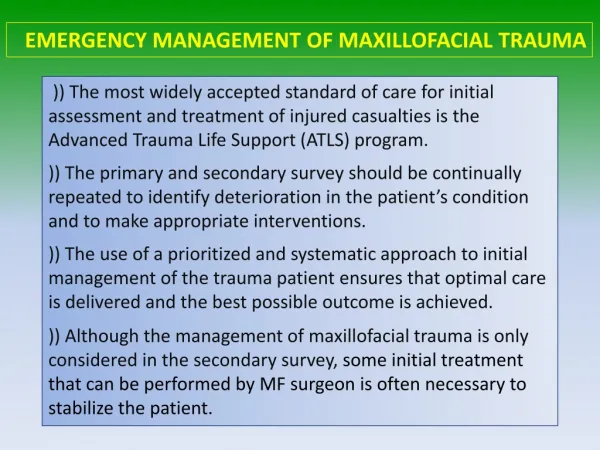
EMERGENCY MANAGEMENT OF MAXILLOFACIAL TRAUMA
EMERGENCY MANAGEMENT OF MAXILLOFACIAL TRAUMA. )) The most widely accepted standard of care for initial assessment and treatment of injured casualties is the Advanced Trauma Life Support (ATLS) program.
916 views • 36 slides
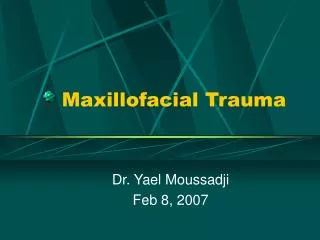
Maxillofacial Trauma
Maxillofacial Trauma. Dr. Yael Moussadji Feb 8, 2007. Objectives. To review a general approach to facial injuries To review specific bony injuries of the face To discuss general wound repair principles and management of soft tissue injuries of the face by anatomic location . Epidemiology.
1.46k views • 56 slides
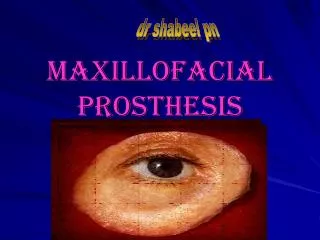
MAXILLOFACIAL PROSTHESIS
dr shabeel pn. MAXILLOFACIAL PROSTHESIS. PROSTHESIS. AN ARTIFICIAL REPLACEMENT OFAN ABSENT PART OF HUMAN BODY. MAXILLOFACIAL PROSTHETICS.
3.27k views • 22 slides
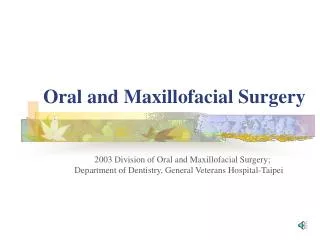
Oral and Maxillofacial Surgery
Oral and Maxillofacial Surgery. 2003 Division of Oral and Maxillofacial Surgery; Department of Dentistry, General Veterans Hospital-Taipei. 台北榮民總醫院口腔顎面外科. 服務項目. 特殊診療項目. 智齒拔除手術 植牙手術 贗復前手術 正顎手術 良惡性腫瘤手術 重建手術 顳顎關節手術. 口腔癌篩檢 人工植牙諮詢. 門診時間. 每週一~週五 上午第三診. 門診手術. 住院手術房. 門診諮詢.
1.06k views • 30 slides

Maxillofacial Trauma
Maxillofacial Trauma. Anatomy. Anatomy. Maxillofacial Region. 1. Fractures of the Nasal Pyramid 2. Fractures of the Central Midface Le Fort Fractures. Maxillofacial Region. 3. Fractures of the Lateral Midface 4. Fractures of the Frontal bone 5. Fractures of the Anterior Skull Base
1.42k views • 50 slides

Maxillofacial Trauma
Maxillofacial Trauma. Joe Lex, MD, FACEP, FAAEM Temple University School of Medicine Philadelphia, PA USA Joseph.Lex@TUHS.Temple.edu. Lecture Outline. Emergency management Facial exam Fractures Major Minor Soft tissue injuries Unusual injuries. FACE. Causes of Mortality. Acute
1.21k views • 67 slides

Maxillofacial Trauma
Maxillofacial Trauma. August 19, 2010 Jay Green Colin Del Castilho. Intro Soft tissue injuries Case work Case discussion Regional anesthesia Bone/joint injuries Case work Case discussion. Intro stuff. Soft tissue injury cases. Case 1. 48y male, intoxicated
760 views • 51 slides

Oral & Maxillofacial Surgery
Oral & Maxillofacial Surgery. Oral & Maxillofacial Surgery. Oral and maxillofacial surgery is surgery to correct a wide spectrum of diseases, injuries and defects in the head, neck, face, jaws and the hard and soft tissues of the oral and maxillofacial region.
1.12k views • 31 slides

Maxillofacial and Ocular Injuries
Maxillofacial and Ocular Injuries. Objectives. At the conclusion of this presentation the participant will be able to: Identify the key anatomical structures of the face and eye and the impact of force on those structures
979 views • 62 slides
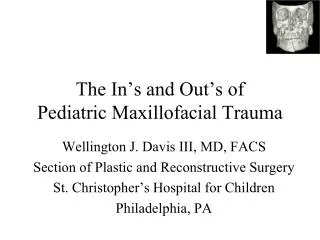
The In’s and Out’s of Pediatric Maxillofacial Trauma
The In’s and Out’s of Pediatric Maxillofacial Trauma. Wellington J. Davis III, MD, FACS Section of Plastic and Reconstructive Surgery St. Christopher’s Hospital for Children Philadelphia, PA. Introduction. Maxillofacial trauma evaluation Key problems and Work-Up
1.11k views • 56 slides
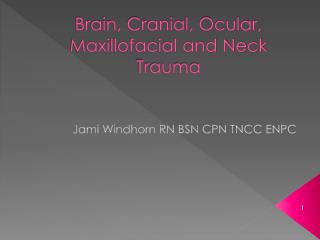
Brain, Cranial, Ocular, Maxillofacial and Neck Trauma
Brain, Cranial, Ocular, Maxillofacial and Neck Trauma. Jami Windhorn RN BSN CPN TNCC ENPC. 1. I have nothing to disclose I have no conflict of interest. Objectives. Identify Common Mechanisms for Brain Injury Describe Pathophysiology of Brain Injury
1.2k views • 85 slides

Dental-maxillofacial Deformities
Dental-maxillofacial Deformities. Dept. of Oral & Maxillofacial Surgery School of Stomatology LI Qing-yun. Phase I. Presurgical treatment. Orthodontics Surgical plan. Phase II. Surgical treatment. Mandible Maxilla. Phase III. Postsurgical treatment. Orthodontics
1.29k views • 31 slides

Maxillofacial, Ophthalmic & Dental Trauma
Maxillofacial, Ophthalmic & Dental Trauma. EMS Professions Temple College. Morbidity & Mortality. Mortality Primarily associated with brain and spine injury Severe Facial fractures may interfere with airway and breathing Morbidity Disability concerns Cosmetic concerns. Causes
652 views • 31 slides
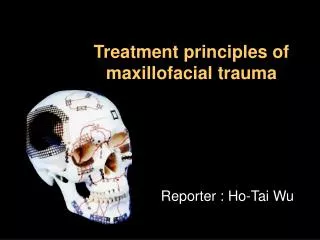
Treatment principles of maxillofacial trauma
Treatment principles of maxillofacial trauma. Reporter : Ho-Tai Wu. Evaluation of p’t with facial trauma Classification of facial fractures Treatment of facial fractures. Maxillofacial Injuries. Treatment divided into following phases Emergency or initial care Early care Definitive care.
2.63k views • 40 slides

















